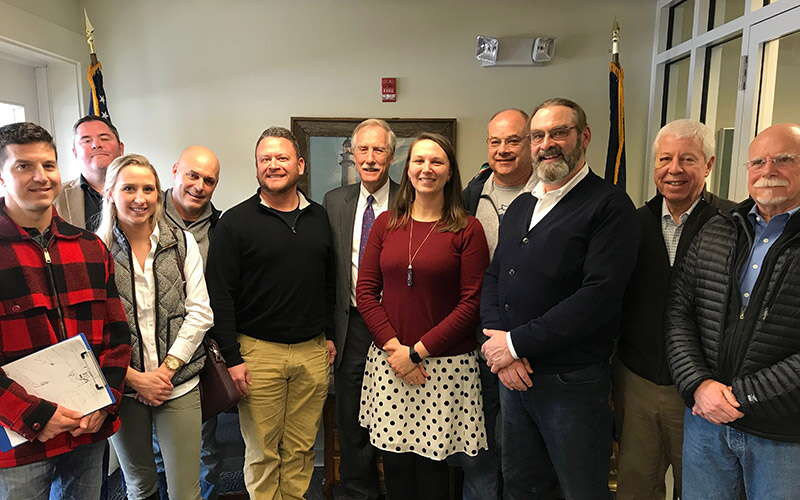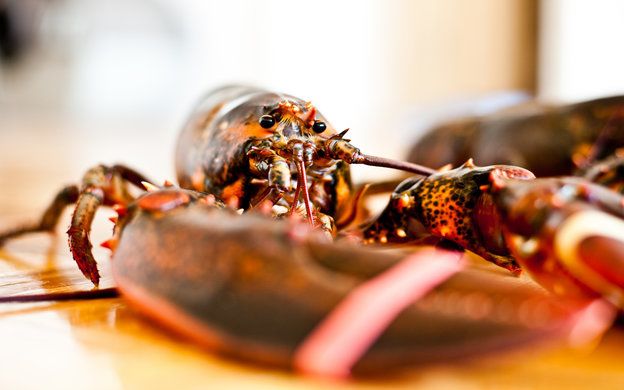
Lobster landings drop 16% in 2017, value drops almost $100M
 Courtesy / Tom Thai, Flickr
Although Maine's lobster landings in 2017 were the sixth highest on record at 110.8 million pounds, that tally represents a 16% decline from 2016's 132.5 million landings total. Value also dropped from an average $4.08 per pound in 2016 to $3.91 a pound — for an overall value of $433.8 million for the state's lobster fishery.
Courtesy / Tom Thai, Flickr
Although Maine's lobster landings in 2017 were the sixth highest on record at 110.8 million pounds, that tally represents a 16% decline from 2016's 132.5 million landings total. Value also dropped from an average $4.08 per pound in 2016 to $3.91 a pound — for an overall value of $433.8 million for the state's lobster fishery.
Although Maine’s lobster landings in 2017 were the sixth highest on record at 110.8 million pounds, that tally represents a 16% decline from 2016’s 132.5 million landings total.
Value also dropped from an average $4.08 per pound in 2016 to $3.91 a pound — for an overall value of $433.8 million for the state’s lobster fishery, which is the fourth-highest value on record but represents an almost $100 million declined from 2016’s all-time record value of $540.4 million.
When accounting for bonuses paid to harvesters by 15 of 20 co-ops, the overall landed value of lobster in 2017 was $450.8 million, according to the Maine Department of Marine Fisheries year-end 2017 report that was released today.
Overall, Maine commercial fishermen landed more than $569 million worth of marine resources in 2017, which is the fourth-highest tally ever and markes only the sixth time that Maine harvesters have surpassed $500 million in total value.
The drop in landings and value for Maine lobsters in 2017 wasn’t unexpected. Lobster co-ops Downeast were reporting in late summer as much as a 25% to 30% drop in volume compared with 2016, with the price per pound also dropping by about 20% at that point in the season.
“The past year has underscored what I’ve been saying for years now – that change is inevitable and we must be prepared,” DMR Commissioner Patrick Keliher said in a news release announcing the 2017 landings. “This year’s decline in lobster landings is by no means a signal that the sky is falling. But it does highlight the need to make sure our management measures adapt to change. This is true for all fisheries. It is the best way to ensure resilience of our marine resources and opportunity for future generations.”
According to National Marine Fisheries Service data, American lobster was the species of highest landed value in the U.S. in 2015 and 2016, and Maine’s landings accounted for approximately 80% of that landed value in 2016.
“The Maine Lobster industry remains strong, thanks to the hard work of the fishermen who have taken great care of the resource for the past 150 years," Matt Jacobson, executive director of the Maine Lobster Marketing Collaborative, said in a written statement sent to Mainebiz. "Our goal as the Maine Lobster Marketing Collaborative is to fuel awareness and drive demand, stabilizing the market for Maine lobster by ensuring consumers around the world are enjoying the delicacy that is part of the fabric of our state.”
Lobster supply chain's value: $1B

Michael Donihue, a professor of economics at Colby College, released today a groundbreaking study he conducted in conjunction with the Maine Lobster Dealers’ Association, that identifies for the first time the economic impact of the entire lobster supply food chain in Maine.
Donihue’s study, which was funded by the Lobster Research, Education and Development Fund, puts the economic impact of the lobster supply chain at $1 billion and states that it generates 4,000 jobs throughout Maine.
Those findings represent the economic footprint of companies operating in the wholesale distribution of live lobster or processed lobster products, as well as upstream and downstream spending ranging from total lobster purchases, wages and taxes, operating expenses and capital investment.
“All of the businesses that operate in Maine’s lobster supply chain are independent companies,” said Annie Tselikis, executive director of the Maine Lobster Dealers’ Association. “As a result, we never knew what the big picture of our own industry really looked like. This is the first in-depth analysis that has been done on the lobster industry, and we are fortunate to have a better understanding of the true impact of this sector. The impact is massive.”
How the other fisheries fared

Herring, the primary bait source for the lobster industry, again represented the second most valuable commercial fishery at just under $18 million, on the strength of a record per-pound price of twenty-seven cents. Harvesters landed 66.45 million pounds.
Despite a drop of nearly 4 million pounds landed and a dip of $3.8 million in value, Maine’s softshell clam industry remained the third most valuable commercial fishery at $12.4 million. “Landings declined in part due to closures associated with harmful algal blooms,” said DMR Public Health Bureau Director Kohl Kanwit. The decline in value is due in part to reported increases in supply of soft shell clams from outside Maine which affected the demand and value for Maine clams.
Maine elver harvesters enjoyed another season in which their fishery was by far the most valuable on a per pound basis. Harvesters landed 9,343 pounds of the 9,688-pound state quota. At $1,303 a pound, the elver fishery was valued at $12.16 million, the fifth highest per pound and overall value in the history of the fishery.
Maine scallop harvesters landed the most scallops since 1997, bringing ashore 793,544 meat pounds, a nearly 45% jump from 2016. At $9.3 million, scallop landings had the highest overall value since 1993. “Management measures developed in cooperation with industry are definitely yielding good results,” Keliher said. “Maine’s scallop fishery continues its impressive rebound thanks in large part to harvesters whose compliance with area closures and limits have been critical to the success of this fishery.”
Gov. Paul R. LePage highlighted the efforts of all the Maine commercial harvesters to practice “sustainable, responsible management of marine resources.
“Not only do they contribute greatly to our state’s economy, they consistently deliver the best seafood in the world,” he said.









Comments